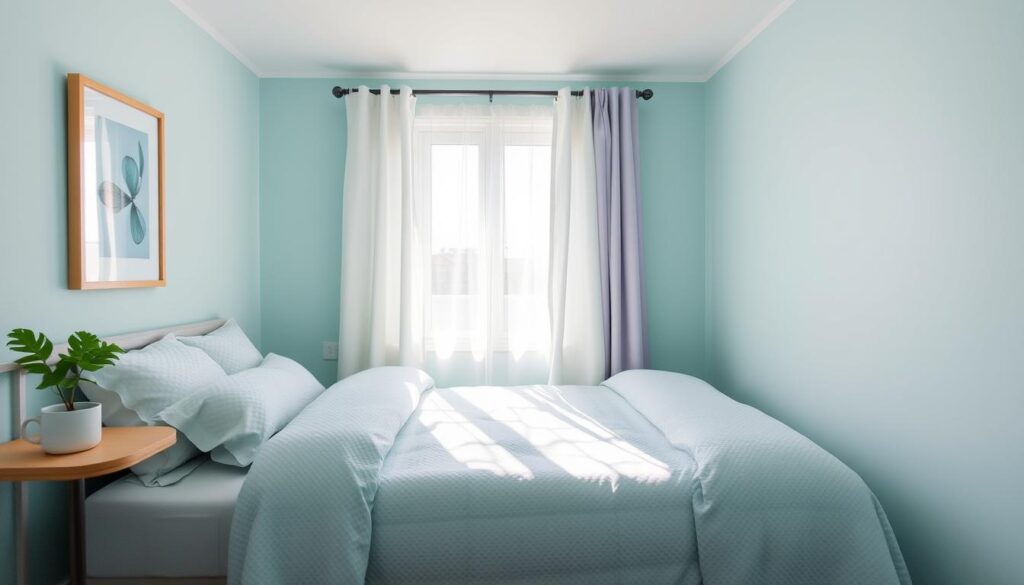Choosing the right colors is key when designing a small guest room. Light and airy hues can make even the tiniest spaces feel bigger and brighter. We’ll look at the top color choices to make your small guest room feel welcoming and spacious.
Key Takeaways
- Light and airy colors can visually expand the size of a small guest room
- Understanding color psychology helps select hues that evoke a calming and relaxing mood
- Neutral palettes and soft pastels are excellent choices for making a space feel more open and spacious
- Coordinating color schemes with existing decor and furniture can create a cohesive and harmonious look
- Maintaining a light and airy aesthetic requires careful consideration of natural lighting and room orientation
Understanding Color Psychology in Small Spaces
Colors deeply affect our mood and how we see a room. In small guest spaces, picking the right colors is key. They help make the room feel bigger and more welcoming.
The Impact of Colors on Mood and Perception
The colors in your small guest room can change how you feel and see the space. Warm colors like soft yellows and peaches bring comfort. Cool colors like blue and green calm the mind. These colors greatly affect the room’s emotional feel.
How Colors Affect Room Dimensions
Using color psychology can make a small room seem bigger. Light colors like whites and pale grays open up a space. Darker colors make it feel cozy but smaller. Choosing colors wisely can make the room look better and feel balanced.
Creating Visual Balance with Color
To balance a small room, think about color combinations carefully. Mixing complementary or analogous colors creates a nice look. Using accent colors adds interest without losing balance.
“Color is a power which directly influences the soul.” – Wassily Kandinsky
Learning about color psychology, room perception, and visual balance can turn a small guest room into a cozy and beautiful spot.
Best Light Paint Colors for Small Guest Rooms
Choosing the right paint color is key for a small guest room. Opt for light paint colors to make the room feel bigger and more welcoming. Here are some top light paint colors to turn a small room into a cozy retreat.
Soft and Serene: Pale Blue and Soft Gray
Soft blue and gray hues create a calm and peaceful vibe in any small guest room. These space-enhancing hues expand the room’s feel while keeping it soothing. They fit perfectly into a small room color palette.
Bright and Airy: Soft White and Ivory
Light paint colors like soft white and ivory are great for making a room feel bigger. These clean tones brighten up a small guest room, making it feel open and inviting.
Fresh and Invigorating: Pale Green and Mint
Pale green or mint can add a refreshing touch to a guest room. These space-enhancing hues bring a natural feel, making the room serene and refreshing.
| Paint Color | Brand | Undertone | LRV (Light Reflectance Value) |
|---|---|---|---|
| Soft Whisper | Sherwin-Williams | Warm | 82 |
| Wickham Gray | Benjamin Moore | Cool | 70 |
| Mint Aqua | Behr | Cool | 75 |
| Alabaster | Sherwin-Williams | Warm | 93 |
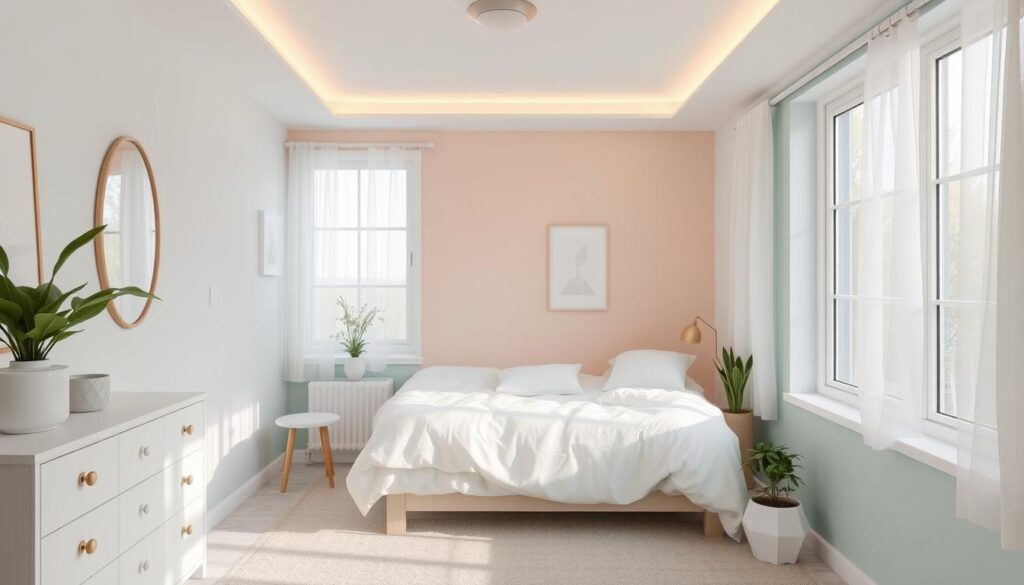
“The right light paint colors can transform the perceived size and ambiance of a small guest room, making it feel more open, airy, and inviting.”
When picking light paint colors for a small guest room, think about the room’s lighting, orientation, and mood you want. Try out paint samples to find the best small room color palette. This will enhance the space and welcome your guests.
Choosing Light and Airy Colors for a Small Guest Room
Choosing the right colors is key for a cozy small guest room. Light and airy hues make the space feel open and welcoming. To pick the best colors, consider natural light, room orientation, and paint samples.
Evaluating Natural Light Conditions
The amount of natural light affects the color choice. Rooms with lots of light can handle a variety of colors, like soft pastels or crisp whites. Rooms with less light might do better with colors that reflect light, such as pale blues or greens.
Considering Room Orientation
The room’s orientation also matters. North-facing rooms have cooler, more subdued light, perfect for warm colors. South-facing rooms have brighter light, great for cool shades.
Testing Paint Samples
Testing paint samples is crucial before making a final choice. It shows how colors look in different light and at different times. Use small wall sections or peel-and-stick samples to find the perfect color.
By thinking about natural light, room orientation, and paint samples, you can pick the right colors. This will turn your small guest room into a cozy retreat.
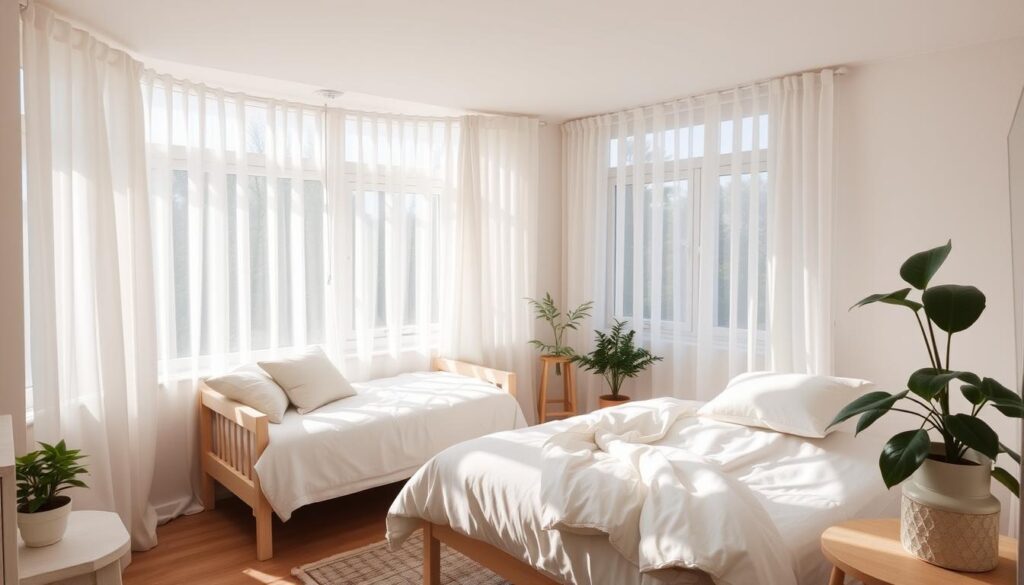
Neutral Color Palettes That Maximize Space
Choosing the right color palette is key for small guest rooms. Neutral colors like beige, gray, and taupe are perfect. They create a calm, sophisticated feel and make the room seem bigger.
Beige tones, from soft ivory to warm camel, are timeless and inviting. They reflect light, making the room feel open and airy. Adding crisp white trims and accents keeps the look cohesive and refined.
Gray shades, from dove to charcoal, also work well in small rooms. They offer a versatile base that can be paired with many accent colors. This lets you add your personal touch while keeping the room feeling spacious.
Taupe tones blend warm and cool undertones, creating a sophisticated look. They range from soft, beige-like grays to rich, earthy shades. This provides a balanced and calming background for your guest room.
“Neutral colors are the unsung heroes of small-space design, effortlessly creating the illusion of a larger, more open environment.”
Using these neutral colors and space-maximizing palettes can change your small guest room. It will feel airy, inviting, and spacious. The goal is to use versatile hues that enhance the room’s size and create a welcoming space for your guests.
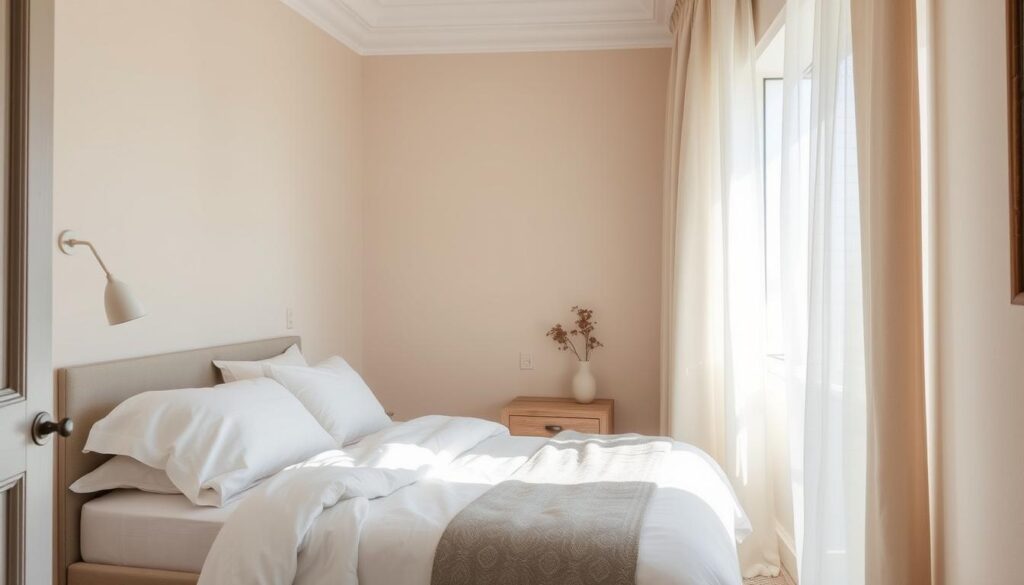
Soft Pastels and Their Space-Enhancing Properties
Soft pastel colors can make a small guest room feel cozy and inviting. They have a special power to make spaces feel more open and airy. The right pastel colors can turn a small room into a welcoming place.
From blush tones to mint and sage, and even light blue and lavender, each shade has its own charm. They can make a small room feel bigger and more welcoming.
Incorporating Blush Tones
Blush tones bring soft, romantic charm to a room. These delicate pinks with a hint of beige add warmth and sophistication. Pair them with crisp white linens and accents for elegance and serenity.
Working with Mint and Sage
Mint and sage hues create a refreshing and calming atmosphere. These soothing greens with a subtle blue undertone make the space feel larger and more inviting. They bring a sense of serenity and rejuvenation.
Light Blue and Lavender Options
Light blue and lavender are perfect for creating tranquility. These soft, airy shades lift the mood and make a room feel more spacious. Pair them with crisp white accents for a calming and sophisticated look.
Color Combinations for a Welcoming Atmosphere
Choosing the right colors is key in a small guest room. It helps make the space warm and inviting. By picking harmonious colors, you can turn a small room into a cozy retreat for your guests.
A soft, muted palette of light blue and lavender is perfect for a small room. These colors make the room feel bigger and calm. Adding crisp white accents brings freshness to the mix.
For a more sophisticated look, try sage green and soft pink. This combo is elegant and soothing. Adding natural wood tones ties everything together, making the room feel welcoming.
| Color Combination | Mood and Atmosphere | Complementary Accents |
|---|---|---|
| Light Blue and Lavender | Calming, Serene, Tranquil | Crisp White, Natural Wood |
| Sage Green and Soft Pink | Refined, Sophisticated, Warm | Natural Wood, Brass Accents |
Choosing the right color combinations can make your guests feel right at home. It creates a harmonious palette that welcomes and comforts everyone.
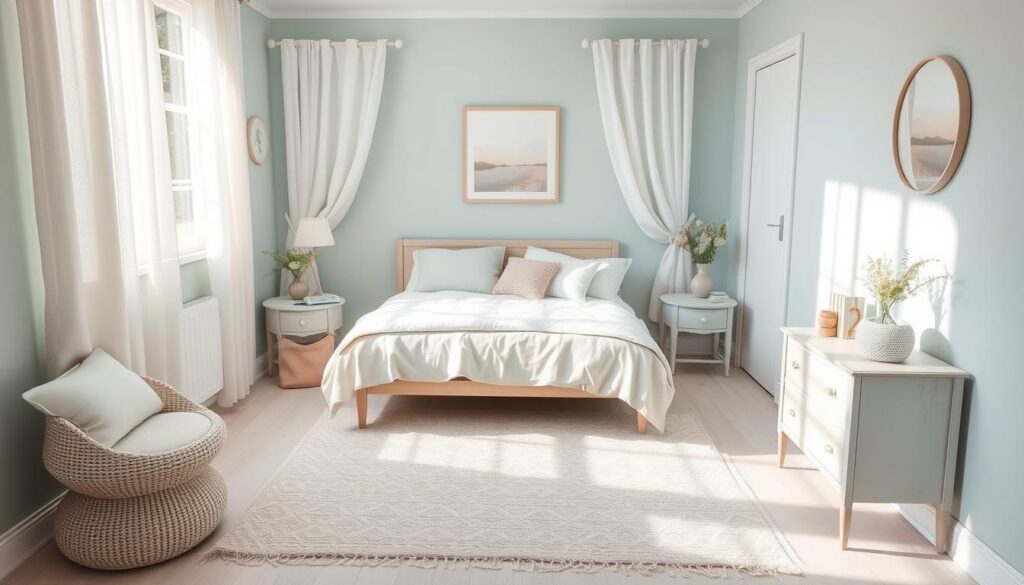
Using White as a Base Color
Using white as the base color in a small guest room can change the game. White is a clean, versatile canvas. It can be easily mixed with different accent colors and textures to get the look you want.
Different Shades of White
Exploring white can be fun. You can find everything from bright, crisp whites to softer, more muted shades. Try out different whites to see which one works best with your room’s lighting and design.
Combining White with Accent Colors
White is a solid base, but adding accent colors can make the room pop. Soft blues, calming greens, or bright yellows can make the space feel welcoming and inviting. They work well with white to create a balanced look.
Texture and White Spaces
Texture is key in making an all-white room look great. You can use plush textiles, natural wood, subtle patterns, or matte finishes. Mixing textures keeps the room interesting and prevents it from feeling flat. Using “white space” helps the eye rest and adds balance.
By using white as the base and adding different shades, colors, and textures, you can make a small guest room feel like a peaceful oasis. This approach makes the room look bigger and creates a cozy, relaxing space for your guests.
Accent Colors That Complement Light Schemes
Using accent colors in a light and airy guest room adds interest and depth. These colors break up the single color feel. They bring vibrancy without taking over the room.
Choosing the right accent colors is key. Look for complementary hues that make the room feel light and calm. Soft, muted tones work well. They blend with the main colors and add a nice contrast.
- Incorporate accent colors through textiles, such as throw pillows, curtains, or a cozy blanket.
- Use color accents in artwork, wall hangings, or decorative accessories to draw the eye and create focal points.
- Experiment with complementary hues in small doses, like a vase, lamp, or decorative tray, to avoid overwhelming the space.
Finding the right balance is important. The light base and accent colors should work together. With the right color accents, your small guest room will be welcoming and eye-catching.
“The right accent colors can transform a room, adding depth, personality, and a sense of cohesion to the overall design.”
Color Coordination with Guest Room Furniture
Designing a small guest room means matching paint colors with furniture. This makes the space look good and leaves a great impression on guests.
Matching Colors with Wood Tones
The wood tones of your furniture greatly affect the room’s color. Light woods like oak or maple go well with soft colors. These colors make the room feel brighter.
Darker woods, such as cherry or walnut, pair with richer colors. These colors match the furniture’s depth.
Coordinating with Existing Decor
Look at the room’s decor, including bedding and curtains. Pick paint colors that match these elements. This creates a space that looks good together.
Stay away from colors that clash with the decor. This can make the room look messy and overwhelming.
Creating Focal Points
Choose colors to highlight certain pieces or areas. For example, paint the wall behind the bed a different color. This makes the headboard stand out.
Also, use an accent wall to show off a chair or dresser. This adds interest and beauty to the room.
By carefully choosing paint colors, you can make your guest room beautiful and welcoming. It’s all about matching colors with furniture and decor.
Tips for Maintaining Light and Airy Aesthetics
Keeping a small guest room light and airy takes some effort, but it’s worth it. A few simple tips can help your cozy space stay welcoming and spacious for years.
Cleaning regularly is crucial for light and airy decor in small spaces. Use eco-friendly cleaners to wipe down surfaces. Also, watch out for dust in corners and crevices. Keeping the room clutter-free is also key for maintaining aesthetics. Get rid of things you don’t use to keep the room feeling open.
Change up your textiles and accessories with the seasons. Use light curtains in summer and swap out throw pillows or artwork to keep things fresh. A new coat of paint can also change the room’s mood and feel.
By spending a little time on cleaning, decluttering, and refreshing your small guest room, it will stay light and airy. These easy steps will help keep the welcoming feel that makes this space so special.
| Maintenance Task | Frequency | Benefits |
|---|---|---|
| Gentle Cleaning | Weekly | Prevents dust buildup, maintains fresh appearance |
| Decluttering | Monthly | Keeps the room feeling open and uncluttered |
| Textile Rotation | Seasonal | Refreshes the room’s look and feel |
| Accent Painting | Yearly | Allows for easy transformation of the room’s mood |
“Maintaining a light and airy aesthetic in a small guest room requires a delicate balance of cleaning, organization, and seasonal updates.”
Conclusion
Choosing the right colors for a small guest room can change everything. Understanding color psychology helps you make a space that feels welcoming and open. Soft pastels, soothing neutrals, or crisp whites are great choices. They should match the room’s natural light and direction.
We’ve looked at many color palettes and design tips for small guest rooms. These can make the room feel bigger and more inviting. By using light colors and matching them with your furniture, you can make a peaceful retreat for your guests.
The secret to picking the best colors for a small guest room is finding a balance. Use the tips from this article to make your room feel light and airy. This way, your guests will leave feeling refreshed and happy. Let color work its magic and create a guest room that impresses everyone.
FAQ
What are the best light paint colors for small guest rooms?
Soft whites, pale grays, airy blues, and calming greens are great for small guest rooms. They make the room feel bigger and more welcoming.
How do I choose the right light and airy colors for my small guest room?
Think about the natural light, room orientation, and test paint samples. This helps pick the best colors for your space.
What are some effective neutral color palettes that can maximize the sense of space?
Shades of beige, gray, and taupe work well in small guest rooms. They create a calm and open feel.
How can I incorporate soft pastel colors in my small guest room?
Use soft pastels like blush, mint, sage, and light blues. They add to the room’s airy feel and make it serene.
What color combinations work well for a welcoming guest room atmosphere?
Pair light colors with complementary accents. This creates a balanced and inviting space.
How can I coordinate paint colors with my guest room furniture?
Match paint colors with wood tones and existing decor. Use color to create focal points. This makes the room look cohesive and appealing.
What tips can I follow to maintain the light and airy aesthetics in my small guest room?
Keep the room clean, decluttered, and refreshed. This helps keep the room feeling spacious and welcoming.
Share this post: on Twitter on Facebook

